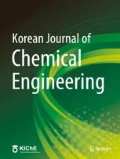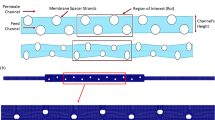Abstract
This study presents an integrated analytical model for the hydrodynamic behavior of the spiral-wound membrane element considering the curvature of the flow feed and permeate channels. The new model introduces a set of closed-form expressions for the output parameters of the permeate flow rate, fluid recovery fraction, and the permeation flux, which can be a necessary tool for optimization and evaluation of the parameters involved in the problem. Accordingly, the results were set forth for a reverse osmosis water treatment SWM element. The difference in the output parameters for the solutions with flat and curved membranes was investigated, and the consequences of the common assumption of the flat-sheet membrane were examined mathematically. It was found that neglecting the membrane curvature implements a significant impact/error on the prediction of the permeate channel pressure and membrane width with maximum permeation rate, whereas its impacts on feed channel pressure and output parameters are insignificant, especially for the considered reverse osmosis case study. Also, the curvature effect on the solution can be magnified by three parameters of the membrane width: permeate channel permeability, and membrane resistance.
Similar content being viewed by others
Abbreviations
- A, B, C:
-
dimensionless parameters defined in the model
- D:
-
diameter of the feed spacer filament [m]
- F:
-
fluid recovery fraction
- f1, f2 :
-
coefficients in pressure drop constitutive law (feed channel)
- k:
-
permeability [m2]
- k1 :
-
permeate channel permeability parallel to the membrane [m2]
- k2 :
-
permeate channel permeability perpendicular to the membrane [m2]
- L:
-
length of the feed spacer filament in a unit cell [m2]
- Lpr :
-
permeate channel height [m]
- Lfr :
-
feed channel height [m]
- Lx :
-
membrane sheet length [m]
- L y :
-
membrane sheet width [m]
- LMH:
-
permeation flux [L/(m2 h)]
- P:
-
permeate channel pressure [Pa]
- p:
-
feed channel pressure [Pa]
- Q:
-
permeate flow rate [L/h]
- R:
-
curvature radius [m]
- Rm :
-
membrane resistance [m−1]
- Re:
-
Reynolds number (Re=ρUD/μ)
- U:
-
velocity in feed channel [m/s]
- Uw :
-
permeation velocity or permeation flux [m/s]
- Θ :
-
angle corresponds to the membrane width [Deg]
- η :
-
dimensionless curvature radius
- ψ :
-
percentage of difference [%]
- α :
-
dimensionless parameter defined in the solution
- β :
-
mesh angle (between the filaments of feed spacer) [Deg]
- ΔP:
-
pressure drop [Pa]
- μ :
-
fluid viscosity [Pa·s]
- ρ :
-
fluid density [kg/m3]
- c:
-
related to selected case study value
- d:
-
dimensionless
- in:
-
inlet
- out:
-
outlet
- i:
-
inner
- o:
-
outer
- f:
-
related to feed channel
- p:
-
related to permeate channel
- r:
-
index notation for cylindrical coordinates
- θ :
-
index notation for cylindrical coordinates
- z:
-
index notation for cylindrical coordinates
- q:
-
quantity (main output parameter)
References
S. Homaeigohar and M. Elbahri, NPG Asia Mater, 9(8), e427 (2017).
M. Elimelech and W A. Phillip, Science, 333(6043), 712 (2011).
A. H. Haidari, S. G. J. Heijman and W. G. J. van der Meer, Sep. Purif. Technol., 192, 441 (2018).
H. S. Abid, D. J. Johnson, R. Hashaikeh and N. Hilal, Desalination, 420, 384 (2017).
C. Bae, K. Park, H. Heo and D. R. Yang, Korean J. Chem. Eng., 34(3), 844 (2017).
D. Lin, Z. Ding, L. Liu and R. Ma, Comput. Chem. Eng., 44, 20 (2012).
M. Taherinejad, S. Derakhshan and A. Yavarinasab, Desalination, 411, 59 (2017).
A. H. Haidari, S. G. J. Heijman and W. G. J. van der Meer, Sep. Purif. Technol., 199, 9 (2018).
A. I. Radu, M. S. H. van Steen, J. S. Vrouwenvelder, M. C. M. van Loosdrecht and C. Picioreanu, Water Res., 64, 160 (2014).
S.S. Hong, W. Ryoo, M.-S. Chun and G.-Y. Chung, Korean J. Chem. Eng., 32(7), 1249 (2015).
B. Gu, C. S. Adjiman and X. Y. Xu, J. Membr. Sci., 527, 78 (2017).
A. Siddiqui, S. Lehmann, V. Haaksman, J. Ogier, C. Schellenberg, M. C. M. van Loosdrecht, J. C. Kruithof and J. S. Vrouwenvelder, Water Res., 119, 304 (2017).
C.P. Koutsou, A.J. Karabelas and M. Kostoglou, Sep. Purif. Technol., 147, 90 (2015).
M. Kostoglou and A.J. Karabelas, Ind. Eng. Chem. Res., 48(22), 10025 (2009).
D. Y. Kim, B. Gu and D. R. Yang, Korean J. Chem. Eng., 30(9), 1691 (2013).
O. Kavianipour, G. D. Ingram and H. B. Vuthaluru, J. Membr. Sci., 526, 156 (2017).
M. Li, T. Bui and S. Chao, Desalination, 397, 194 (2016).
V. V. Ranade and A. Kumar, J. Membr. Sci., 271(1-2), 1 (2006).
Y. Li and K. Tung, J. Membr. Sci., 319(1-2), 286 (2008).
Y. L. Li, K.L. Tung, M. Y. Lu and S.H. Huang, J. Membr. Sci., 329(1-2), 106 (2009).
Y. L. Li, K. L. Tung, Y. S. Chen and K. J. Hwang, Desalination, 287, 200 (2012).
S. Wardeh and H. P. Morvan, Desalination and Water Treatment, 1(1-3), 277 (2009).
K. L. Tung, H. C. Teoh, C. W. Lee, C. H. Chen, Y. L. Li, Y. F. Lin, C. L. Chen and M. S. Huang, J. Membr. Sci., 495, 489 (2015).
A.J. Karabelas, M. Kostoglou and C.P. Koutsou, Desalination, 356, 165 (2015).
M. Taherinejad, J. Gorman, E. Sparrow and S. Derakhshan, J. Membr. Sci., 563, 210 (2018).
C. P. Koutsou, S. G. Yiantsios and A. J. Karabelas, J. Membr. Sci., 291(1-2), 53 (2007).
P. Sousa, A. Soares, E. Monteiro and A. Rouboa, Desalination, 349, 22 (2014).
M. Kostoglou and A. J. Karabelas, Desalination, 316, 91 (2013).
M. B. Minhas and W.-S. Kim, Desalination and Water Treatment, 54(9), 2343 (2014).
P. P. Mane, P. K. Park, H. Hyung, J. C. Brown and J. H. Kim, J. Membr. Sci., 338(1-2), 119 (2009).
H. Boulahfa, S. Belhamidi, F. Elhannouni, M. Taky, A. El Fadil and A. Elmidaoui, J. Environ. Chem. Eng., 7(2), 102937 (2019).
Author information
Authors and Affiliations
Corresponding author
Rights and permissions
About this article
Cite this article
Taherinejad, M., Moghimi, M. & Derakhshan, S. Hydrodynamic modeling of the spiral-wound membrane module including the membrane curvature: reverse osmosis case study. Korean J. Chem. Eng. 36, 2074–2084 (2019). https://doi.org/10.1007/s11814-019-0372-1
Received:
Accepted:
Published:
Issue Date:
DOI: https://doi.org/10.1007/s11814-019-0372-1



